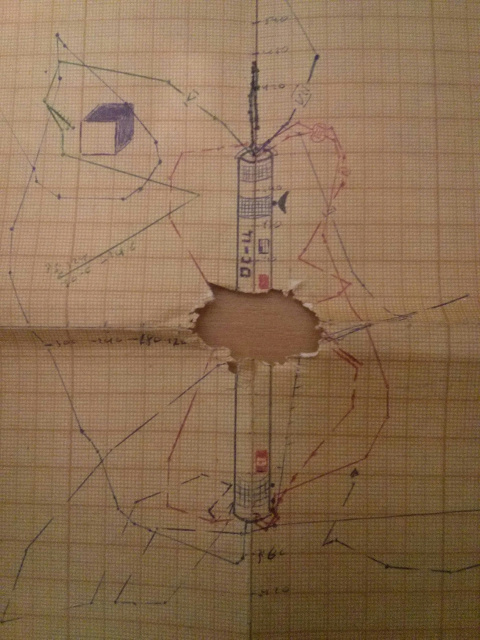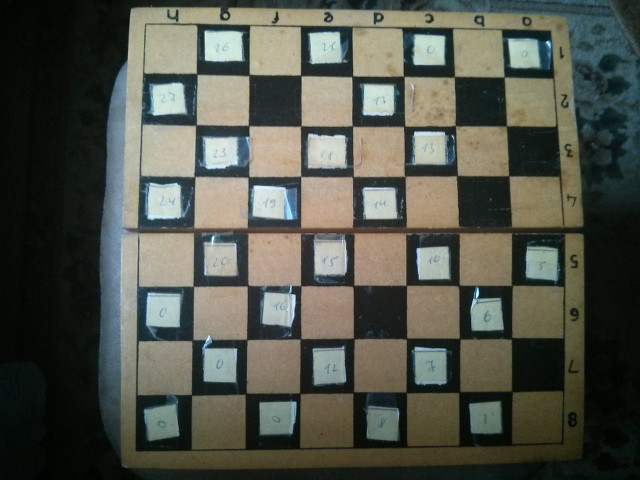About mobile applications in the Soviet Union
Some time ago I found in my barn old storage media with software for a Soviet mobile device. Having started a mean male tear in the good old days, I decided to tell the readers about my first steps in the field of IT.
TTX
The device about which I wrote is a programmable calculator (PMK) 'Electronics MK-61' . This calculator used the reverse Polish notation (hello, Forth!), So almost everyone who saw it for the first time asked: "Where is the same here?" Also, the calculator had 15 registers for storing data and 105 bytes of RAM.

So in my childhood the toys were not even kilobyte.
After turning off the power of the RAM was cleared and the next time you turn on the program had to re-enter. Later came the 'Electronics MK-52' , which had not only non-volatile memory, but also the ability to connect memory expansion units (PDUs) with additional programs.
PMK Store / Play
In the USSR, several dozen books were published on the PMK and programs for them. For example, my first textbook was Calculator - your assistant and rival in games . I got it even earlier than the calculator itself. It was also released several PDUs for the MK-52.
But, perhaps, a number of Soviet journals made the greatest contribution to the popularization of the PMH and programming. One of the first to write about the PMH was the journal Science and Life. Also, a number of articles published by the magazine "Kvant". With rare exceptions, application programs were mainly considered. There were quite a few games. The situation has radically changed with the appearance in the magazine “Technique of Youth” (“TM”) of the column “Club of electronic games”. Over the years of its existence, the rubric has not only published a wide variety of gaming programs, but also paid much attention to the undocumented features of the PMK. Another magazine that paid attention to game programs was the Ukrainian "Pioneer".
In 1988, the Game Lovers Club (CLIP) appeared, a kind of social network (or more precisely BBS) by correspondence. Club
combined up to 600 users of the PMK from all over the USSR. CLIP history can be found here and here .
Game classification
Despite the rather limited resources of the MVP, a large number of gaming programs were developed for them. Can
highlight several genres of games.
Simulators
There were many different simulators. As a rule, the process of the game looked like this. The player introduced new values of a number of parameters (fuel consumption, new speed, angle of inclination, period of time during which these parameters operated) and started the calculations. After some time, the PMK showed the new position and parameters of the simulated object (height or distance, new speed, etc.). Since the space theme was very popular during Soviet times, there were a number of simulators of space flying simulators. In "TM" was published the fantastic story "The Path to the Earth" , in which the characters on a small lunolet fly from the Moon to the Earth. Each chapter described one of the stages of the journey. In addition to this, chapters were also accompanied by one or several programs with the help of which readers could make sure that everything described is true . Thus, the authors of "TM" created a work of art on programs for computers (or programs on the book) long before it became mainstream.
Map of my flights in the vicinity of the orbital station "Yuri Gagarin"

(unfortunately, a meteorite hit the station)
Strategies
The first economic strategy I played was the Merry farmer simulator of a collective farm: it was necessary to plant various agricultural crops and harvest. After the Soviet Union allowed citizens to engage in self-employment (then it was so called), a simulator of a cooperative cafe appeared.
There were also military strategies. For example, it was possible to repeat the battle of Thermopylae or the Neva Battle.
Tabletop
It is obvious that it is impossible to teach PMK to play checkers, and especially chess. However, to play some endgames is quite realistic.
Photo of the chessboard marked for the game with the PMK:

The most interesting game for me was the Wolf and the sheep . It quickly turned out that it was not interesting to play on an ordinary 8x8 chessboard: four sheep always win, and three lose. Therefore, a 9x9 version of the game was developed. And although it was impossible to implement the minimax algorithm, the final program was pretty strong. This game impressed me so much that I later made an option for MS-DOS, and a couple of years ago for Android.
Dynamic video games
Two features of the PMK allowed even dynamic video games to be implemented. First, during the calculations, some current values were displayed on the indicator. Thus it was possible to demonstrate a dynamic "picture". Secondly, in the first models of calculators there was an amusing hardware bug. PMK had a switch "RG" for calculating trigonometric functions in degrees and radians, respectively. It soon became clear that if you do not set the switch to the extreme positions, but fix it in the center, it will perform calculations in degrees (100 degrees - this is 90 degrees). Soon this bug was turned into a feature: the third state of the "GRD" state appeared at the switch. If we calculate the value of cos100 , then we can determine the position of the switch: for degrees, we get the value -0.17 , i.e. negative value, for grads - naturally, 0 , for radians - 0.19 - a positive number. All games of this genre were built on the same principle: the PMK for some time showed on the screen the current situation, giving the player the opportunity to make a decision. Then determined the position of the switch "P-GRD-G" and perform calculations. From the side it looked quite funny: the player was peering at the blinking screen and frantically pulling the switch.
Herology
Like any self-respecting computer, the PMK could display hexadecimal numbers. But due to the limitations of the indicator, they looked a bit strange. For example, " A " was designated as " - ", " B " - " L ". When errors occurred, the calculator returned the word " Error ", but it looked like " EGOGG ", which gave the name to the process of studying the undocumented features of the PMK. By performing cunning operations on very large numbers (which the calculator could not theoretically display), or by addressing large addresses of program memory one could get various inscriptions.
For example, in the game "Lunolet-3" from the story "Path to the Earth" the position of the lunolet relative to the Earth and the Moon was displayed as follows:

" E " - Earth, " O " - Moon, " - " - lunolet.
Calculators MK-61/52 supported the operations of Boolean algebra. But they were usually used only to form a series of messages: “ 8CE ” - the game is over, “ 8-L8EC ” - a man lost. There were also a few games that used these operations to encode mazes.
In more detail the history of the PMK is described here , and here a large set of games.
Simulators and emulators PMK
There are several simulators PMK, for example, "Calculators-3000". There is also a real emulator [emu145] ( https://code.google.com/archive/p/emu145/ ). The author of the emulator - Felix Lazarev - even bought a professional
microscope for photographing microcontrollers series 145/745. In this forum, you can follow the history of development.
Based on emu145 Stanislav Borutsky created an emulator for Android.
My way
My calculator MK-61 appeared in 1989. It turned out that I did not know about the existence of the CLIP. Most of the programs were scooped out of "TM" - either rewritten in the library (there were no copiers at that time), or they were taken from their comrades (as a rule, they did not give it back). We have had Science and Life magazines for several years. But mostly application programs were printed in it, which I was not very interested in. However, more than playing, I liked to write programs. By the way, I never understood the charms of Dendy-type consoles - after all, they could not be programmed at home. My first toy was a space simulator, written under the influence of "Lunolet". It was in the 6th grade, we learned only uniform rectilinear motion by the lessons of physics. Therefore, playing it was not very interesting. I spent more time on programming than on the game itself. Then there was a number of programs. My most serious program was the implementation of kalakh (mankaly). Despite the limited resources of the PMK, he won from me quite often. I do not even know when I was more happy: when I won myself or when I lost to my program.
Several photos of previously mentioned storage media:



Not so long ago, the circle closed and I again write programs for mobile devices.
To try
On Habré there were several articles on programming PMK: one , two , three
Of course, a real zadrot man will gladly spend half an hour driving a program code in order to play for five minutes. For those that are weak in spirit, I prepared a special version of the emulator with support for export / import of programs (I placed this emulator on my own behalf with the permission of Stanislav). I also prepared several programs for this emulator. It is enough to copy * pmk-file to your smartphone and import it into the emulator.
Enjoy learning!
PS The shed in which I found my notebooks had a metal door with the inscription "EU-1050".
UPD. Zenitchik recalled that there is a continuation of the series: MK-152/162
')
Source: https://habr.com/ru/post/369333/
All Articles